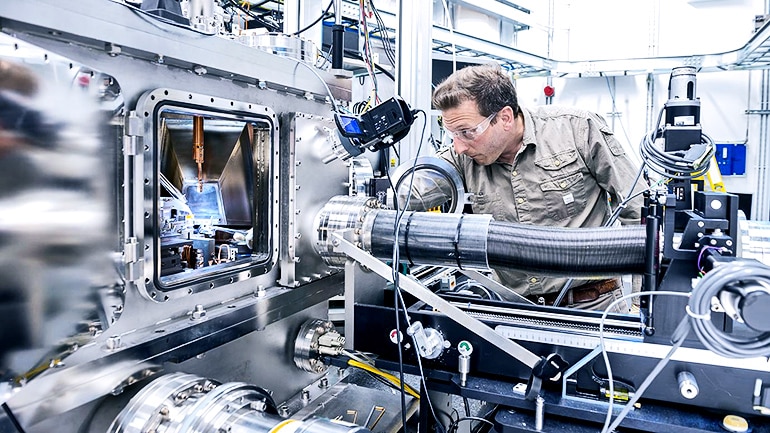Researchers have invented a way for different types of quantum technology to “talk” to each other using sound.
Researchers are eyeing quantum systems, which tap the quirky behavior of the smallest particles as the key to a fundamentally new generation of atomic-scale electronics for computation and communication. But transferring information between different types of technology, such as quantum memories and quantum processors is a persistent challenge.
The new study is an important step in bringing quantum technology closer to reality.
“We approached this question by asking: Can we manipulate and connect quantum states of matter with sound waves?” says senior author David Awschalom, professor with the Institute for Molecular Engineering at the University of Chicago and senior scientist at Argonne National Laboratory.

Sound and ‘spins’
One way to run a quantum computing operation is to use “spins”—a property of an electron that can be up, down, or both. Scientists can use these like zeroes and ones in today’s binary computer programming language. But getting this information elsewhere requires a translator, and scientists thought sound waves could help.
“The object is to couple the sound waves with the spins of electrons in the material,” says graduate student Samuel Whiteley, the co-first author on the paper. “But the first challenge is to get the spins to pay attention.”

So researchers built a system with curved electrodes to concentrate the sound waves, like using a magnifying lens to focus a point of light.
The results were promising, but they needed more data. To get a better look at what was happening, they worked with scientists at the Center for Nanoscale Materials at Argonne to observe the system in real time.
Essentially, they used extremely bright, powerful X-rays from the lab’s giant synchrotron, the Advanced Photon Source, as a microscope to peer at the atoms inside the material as the sound waves moved through it at nearly 7,000 kilometers per second (around 4350 miles per second).
Subatomic investigation
“This new method allows us to observe the atomic dynamics and structure in quantum materials at extremely small length scales,” says Awschalom. “This is one of only a few locations worldwide with the instrumentation to directly watch atoms move in a lattice as sound waves passes through them.”
One of the many surprising results, the researchers say, was that the quantum effects of sound waves were more complicated than they’d first imagined.
It’s normally difficult to send quantum information more than the width of a single strand of spider silk.
To build a comprehensive theory behind what they were observing at the subatomic level, they turned to Giulia Galli, a professor at the IME and a senior scientist at Argonne. Modeling the system involves marshaling the interactions of every single particle in the system, which grows exponentially, Awschalom says, “but Professor Galli is a world expert in taking this kind of challenging problem and interpreting the underlying physics, which allowed us to further improve the system.”
It’s normally difficult to send quantum information for more than a few microns, says Whiteley—that’s the width of a single strand of spider silk. This technique could extend control across an entire chip or wafer.
“The results gave us new ways to control our systems, and opens venues of research and technological applications such as quantum sensing,” says postdoctoral researcher Gary Wolfowicz, the other co-first author of the study.
The research appears in Nature Physics. The Pritzker Nanofabrication Facility at the William Eckhardt Research Center fabricated the devices. Funding for the work came from the Air Force Office of Scientific Research, the US Department of Energy Office of Basic Energy Sciences, National Science Foundation, and the Department of Defense.
Source: University of Chicago



